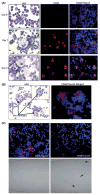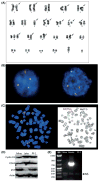Involvement of tumor-associated macrophage activation in vitro during development of a novel mantle cell lymphoma cell line, PF-1, derived from a typical patient with relapsed disease
- PMID: 24611650
- PMCID: PMC5779854
- DOI: 10.3109/10428194.2014.901511
Involvement of tumor-associated macrophage activation in vitro during development of a novel mantle cell lymphoma cell line, PF-1, derived from a typical patient with relapsed disease
Abstract
Human mantle cell lymphoma (MCL) cell lines are scarce and have been only sporadically described and validated, and only a few have been thoroughly molecularly or genetically characterized. We describe here the successful establishment of a new MCL line, PF-1, with typical MCL characteristics. Culturing primary MCL cells in vitro initially gave rise to an essential generative microenvironment "niche" involving macrophages required for MCL growth, and eventually produced the PF-1 MCL cell line. Our analysis revealed that PF-1 is morphologically and genotypically nearly identical to the original tumor cells. The PF-1 MCL cell line that we have developed will be useful for in vitro and in vivo studies of MCL pathogenesis and therapeutics.
Keywords: Mantle cell lymphoma cell line; in vitro microenvironment; macrophages.
Conflict of interest statement
Figures



References
-
- Dreyling M. Therapy of mantle cell lymphoma: new treatment options in an old disease or vice versa? Semin Hematol. 2011;48:145–147. - PubMed
-
- Jares P, Campo E. Advances in the understanding of mantle cell lymphoma. Br J Haematol. 2008;142:149–165. - PubMed
-
- Smith MR. Should there be a standard therapy for mantle cell lymphoma? Future Oncol. 2011;7:227–237. - PubMed
-
- Harris NL, Jaffe ES, Stein H, et al. A revised European-American classification of lymphoid neoplasms: a proposal from the International Lymphoma Study Group. Blood. 1994;84:1361–1392. - PubMed
Publication types
MeSH terms
Substances
Grants and funding
LinkOut - more resources
Full Text Sources
Other Literature Sources
Research Materials
